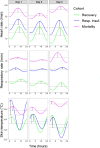Circadian patterns of heart rate, respiratory rate and skin temperature in hospitalized COVID-19 patients
- PMID: 35797369
- PMCID: PMC9262173
- DOI: 10.1371/journal.pone.0268065
Circadian patterns of heart rate, respiratory rate and skin temperature in hospitalized COVID-19 patients
Abstract
Rationale: Vital signs follow circadian patterns in both healthy volunteers and critically ill patients, which seem to be influenced by disease severity in the latter. In this study we explored the existence of circadian patterns in heart rate, respiratory rate and skin temperature of hospitalized COVID-19 patients, and aimed to explore differences in circadian rhythm amplitude during patient deterioration.
Methods: We performed a retrospective study of COVID-19 patients admitted to the general ward of a tertiary hospital between April 2020 and March 2021. Patients were continuously monitored using a wireless sensor and fingertip pulse oximeter. Data was divided into three cohorts: patients who recovered, patients who developed respiratory insufficiency and patients who died. For each cohort, a population mean cosinor model was fitted to detect rhythmicity. To assess changes in amplitude, a mixed-effect cosinor model was fitted.
Results: A total of 429 patients were monitored. Rhythmicity was observed in heartrate for the recovery cohort (p<0.001), respiratory insufficiency cohort (p<0.001 and mortality cohort (p = 0.002). Respiratory rate showed rhythmicity in the recovery cohort (p<0.001), but not in the other cohorts (p = 0.18 and p = 0.51). Skin temperature also showed rhythmicity in the recovery cohort (p<0.001), but not in the other cohorts (p = 0.22 and p = 0.12). For respiratory insufficiency, only the amplitude of heart rate circadian pattern increased slightly the day before (1.2 (99%CI 0.16-2.2, p = 0.002)). In the mortality cohort, the amplitude of heart rate decreased (-1.5 (99%CI -2.6- -0.42, p<0.001)) and respiratory rate amplitude increased (0.72 (99%CI 0.27-1.3, p = 0.002) the days before death.
Conclusion: A circadian rhythm is present in heart rate of COVID-19 patients admitted to the general ward. For respiratory rate and skin temperature, rhythmicity was only found in patients who recover, but not in patients developing respiratory insufficiency or death. We found no consistent changes in circadian rhythm amplitude accompanying patient deterioration.
Conflict of interest statement
The authors have declared that no competing interests exist.
Figures
Similar articles
-
Circadian rhythm disruption was observed in hand, foot, and mouth disease patients.Medicine (Baltimore). 2015 Mar;94(10):e601. doi: 10.1097/MD.0000000000000601. Medicine (Baltimore). 2015. PMID: 25761178 Free PMC article.
-
The impact of heart rate circadian rhythm on in-hospital mortality in patients with stroke and critically ill: Insights from the eICU Collaborative Research Database.Heart Rhythm. 2022 Aug;19(8):1325-1333. doi: 10.1016/j.hrthm.2022.03.1230. Epub 2022 Mar 31. Heart Rhythm. 2022. PMID: 35367661
-
A big data analysis of fever threshold and vital sign characteristics using tympanic temperature in hospitalized patients.Sci Rep. 2024 Nov 10;14(1):27470. doi: 10.1038/s41598-024-79080-0. Sci Rep. 2024. PMID: 39523412 Free PMC article.
-
Association of Continuously Measured Vital Signs With Respiratory Insufficiency in Hospitalized COVID-19 Patients: Retrospective Cohort Study.Interact J Med Res. 2022 Nov 23;11(2):e40289. doi: 10.2196/40289. Interact J Med Res. 2022. PMID: 36256803 Free PMC article.
-
Circadian variation in sports performance.Sports Med. 1996 Apr;21(4):292-312. doi: 10.2165/00007256-199621040-00005. Sports Med. 1996. PMID: 8726347 Review.
Cited by
-
In light of breathing: environmental light is an important modulator of breathing with clinical implications.Front Neurosci. 2023 Jul 13;17:1217799. doi: 10.3389/fnins.2023.1217799. eCollection 2023. Front Neurosci. 2023. PMID: 37521684 Free PMC article.
-
Postoperative circadian patterns in wearable sensor measured heart rate: a prospective observational study.J Clin Monit Comput. 2024 Feb;38(1):147-156. doi: 10.1007/s10877-023-01089-z. Epub 2023 Oct 21. J Clin Monit Comput. 2024. PMID: 37864755 Free PMC article.
-
Lessons Learned from Telemonitoring in an Outpatient Bariatric Surgery Pathway-Secondary Outcomes of a Patient Preference Clinical Trial.Obes Surg. 2023 Sep;33(9):2725-2733. doi: 10.1007/s11695-023-06637-9. Epub 2023 Jul 7. Obes Surg. 2023. PMID: 37415024 Free PMC article.
-
The Molecular Circadian Clock of Phox2b-expressing Cells Drives Daily Variation of the Hypoxic but Not Hypercapnic Ventilatory Response in Mice.Function (Oxf). 2023 May 13;4(4):zqad023. doi: 10.1093/function/zqad023. eCollection 2023. Function (Oxf). 2023. PMID: 37342417 Free PMC article.
-
Quantifying physiological stability in the general ward using continuous vital signs monitoring: the circadian kernel density estimator.J Clin Monit Comput. 2023 Dec;37(6):1607-1617. doi: 10.1007/s10877-023-01032-2. Epub 2023 Jun 2. J Clin Monit Comput. 2023. PMID: 37266711 Free PMC article.
References
-
- Born J, Lange T, Hansen K, Mölle M, Fehm HL. Effects of sleep and circadian rhythm on human circulating immune cells. J Immunol. 1997;158: 4454–64. - PubMed
MeSH terms
LinkOut - more resources
Full Text Sources
Medical
Miscellaneous




